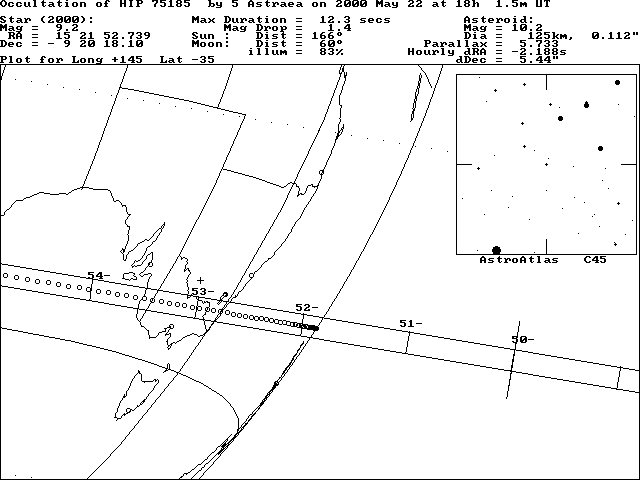ASTROMETRIC UPDATE:
OCCULTATION BY (5) ASTRAEA - 2000 MAY 22
CHECK THIS PAGE REGULARLY FOR FURTHER UPDATES AND CHANGES TO THE TRACK.
YOU MUST RELOAD THIS PAGE USING YOUR BROWSER'S
RELOAD/REFRESH BUTTON TO OBTAIN UPDATES!
[Prediction by Edwin Goffin]
[Prediction using OCCULT software]
[Detailed finder chart by Jan Manek]
Goffin's path crosses the southern New South Wales coast around Woollongong at low altitude passing around Canberra and then to the south of Adelaide. The path then just clips the southern most coastal areas of Western Australia. The path given by OCCULT is around 1 minute earlier and about 1 path width to the north. It crosses the Sydney area, passing to the north of Canberra and also covers Adelaide. Areas of Western Australia south of a line from Cape Knob to Cape Leeuwin are also predicted to be inside the path track.
UPDATE: 19 May 2000
This prediction update has been computed by Jan Manek based on astrometry from Ron Stone of the US Navel Observatory - Flagstaff Station, Bill Owen of TMO and the Hipparcos astrometric satellite mission. The Hipparcos position of the target star has been used.
Summary:
This update indicates a path shift to the south with virtually no change in time relative to that given by Goffin. The path crosses the southern New South Wales coast around Ulladulla (17:52:45 UT - target star altitude = 23°). The path runs just to the south of Canberra, including the towns of Albury, Wangaratta and Bendigo. The path runs just to the north of Melbourne (17:53:10 UT - target star altitude = 27°). The path then crosses the South Australian coastline to the north of Millicent (17:53:30 UT - target star altitude = 31°). The path now misses the southern coast of Western Australia (17:55:45 UT) though is still quite close and well worth monitoring.
Note that with an expected magnitude of 10.2, observers can expect to be able to see the asteroid. In this case, an occultation will appear as a dimming rather than a disapperence of the star. Careful attention is therefore required to monitor this event (see note below about nearby star). Observations made by non-visual techniques (eg. video) are most welcome.
With the very extensive set of astrometry used in this calculation, the path uncertainty for this event is only 0.55 of a path width. Consequently, an organised program of observers spread across the predicted path could easily result in a detailed study of the size and shape of (5) Astraea.
THE EVENT AT ONE GLIMPSE:
- Date and approx. UT time of event: May 22, 2000 @ 17:53 UT
- Magnitude of target star: 9.2
- Magnitude drop [mag]: 1.4
- Estimated maximum duration [s]: 12.3
- Path description: See above.
- Goffin's original chart reference: A00_0502
The Occultation Path:
- Approximate width [km]: 140
- Uncertainty [path widths]: 0.55
- Uncertainty in time [s]: 10
- Map: See below
- Remarks: Uncertainities are given on the basis of the nominal star position errors and the expected asteroid positional accuracy.
- Circles along the path are OCCULT calculated exact centerline points. Note that the times given on the map below have a negative (-) symbol in front of them. This is to indicate that the predicted times are before 18:00 UT.
Data for the target star:
Data for the minor planet:
- Number, name: (5) Astraea
- Approx. diameter [km]: 125
- Source of used astrometry: US Navel Observatory - Flagstaff Station (Ron Stone), TMO (Bill Owen), Hipparcos
- Number of used observations: 49 USNO, 23 TMO, 90 HIP
- Number of rejected observations: 11 USNO, 2 TMO, 8 HIP
- Time covered by the observations: 1990 07 22 - 2000 05 14
- RMS residuals ["] (RA,DE): 0.05", 0.05"
- Estimated positional accuracy at epoch of event ["]: 0.05"
Data for the event:
- UT date and time of least geocentric approach: 2000 May 22, 18:01.5 UT
- Approx. V mag of minor planet at event [mag]: 10.2
- Geocentric parallax of minor planet ["]: 5.733
- Magnitude drop [mag]: 1.4
- Estimated maximum duration [s]: 12.3
- Apparent motion of minor planet ["/h]: 32.85
- Angular distance to moon, phase of moon [deg,%]: 60, 83%
- Update computed by: Jan Manek

IMPORTANT NOTE!
Astrometric updates such as these should not be taken as definitive, but rather only as an indication of where the true track may lie relative to the original predicted track. Observers must bear in mind that later astrometry, in which the target star is measured in the same field as the asteroid, may still reveal substantial changes to the predicted track and time of the event. For this reason it is most important that observers far from the predicted track still monitor the event.
Use these links for further information:
[Planetary Occultations]
[Using the Predictions]
[Observing Details]
[Timing Details]
[Reporting Details]
[Report Form]
[Asteroid Occultation Results]
This page may have been updated since 19 May 2000.
Hit your browser's RELOAD button to get the latest version.
[Site Map]
[What's an Occultation?]
[Total Occultations]
[Grazing Occultations]
[Planetary Occultations]
[Jovian Satellite Eclipses]
[Timing Occultations]
[Reporting Observations]
[Coming Events]
[Software]
[About Us]
[Publications]
[Membership]
[Links]
[Top of Page][Return to Home Page]
